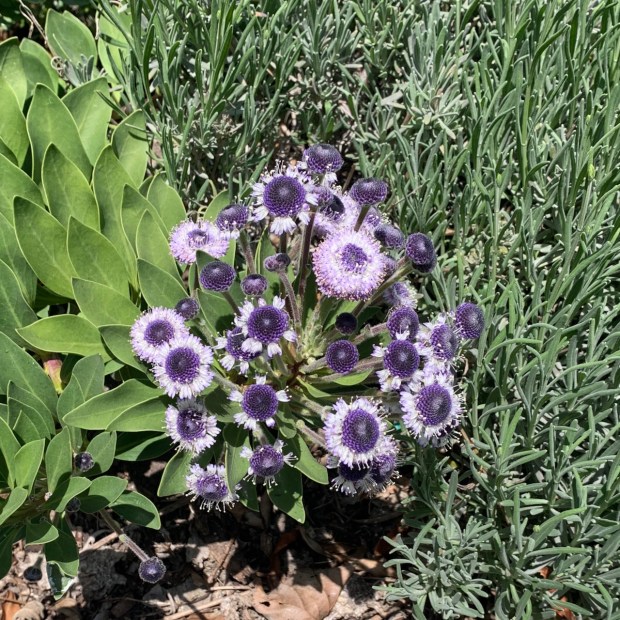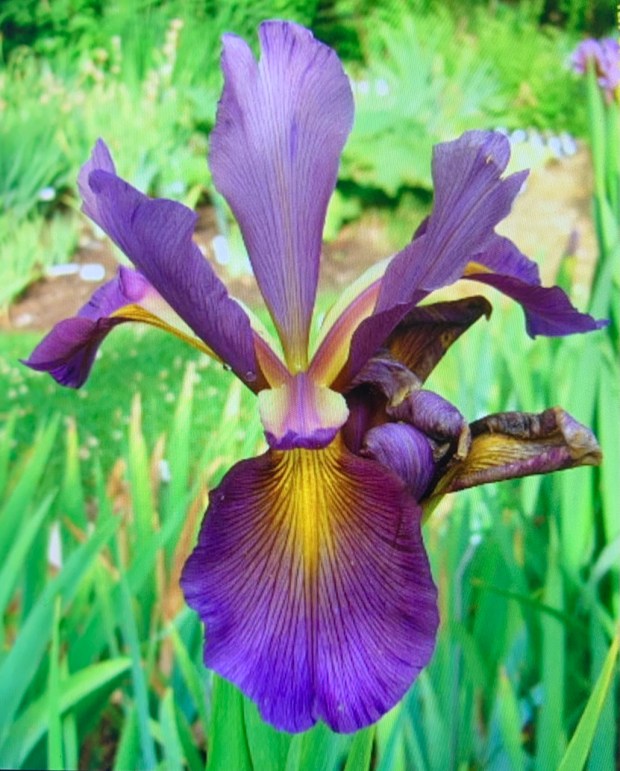Tricolor aeonium (Aeonium haworthii ‘Kiwi’). A variety of the pinwheel aeonium (A. haworthii), this succulent is appreciated for its spoon-shaped leaves, colored with shades of yellow and green, and brilliant red tips. In summer, pink-tinged cream to pale-yellow flowers rise above the leaves on branched spikes. (Courtesy Tom Karwin)

Common hollyhock (Alcea rosea ‘Double Purple’). This plant could be an annual, biennial or even perennial, because it self-sows and blossoms in its first year. It grows up to 8 feet tall, without support. A member of the mallow plant family (Malvaceae), its relatives include the hibiscus. (Courtesy Tom Karwin)

Globe daisy (Globularia sarcophylla ‘Blue Eyes’). This cultivar has blue flowers in solitary heads about 0.59 inches across, on 2-inch-long terminal peduncles. From early summer through fall, it produces “powder puff” blossoms, lavender and white with cobalt centers. (Courtesy Tom Karwin)

Blue iris (Iris spuria ‘Always a Mystery’). The American Iris Society (wiki.irises.org) describes this cultivar as “Midseason bloom. Dusky smoky lavender, old gold blended falls signal, old gold style arm margins.” Anna and David Cadd (whom I’ve met) registered this cultivar in 2002. This hybrid has unknown parentage, perhaps inspiring its cultivar name. (Credit – Aurora Botanicals Iris Garden via American Iris Society Encyclopedia)

English lavender (Lavandula angustifolia). We present this specimen in a desirable setting, without being crowded by adjacent plants. We have trained the rabbit to protect the plants. (Courtesy Tom Karwin)
Show Caption
1 of 5
Tricolor aeonium (Aeonium haworthii ‘Kiwi’). A variety of the pinwheel aeonium (A. haworthii), this succulent is appreciated for its spoon-shaped leaves, colored with shades of yellow and green, and brilliant red tips. In summer, pink-tinged cream to pale-yellow flowers rise above the leaves on branched spikes. (Courtesy Tom Karwin)
Expand
Our previous column introduced a project to exchange two groups of plants to provide better growing conditions: moving aeoniums from the ground to containers in semi-shade, and moving mangaves from large containers in semi-shade to the ground in full sun.
The project involves replanting these two groups of plants and removing a few plants from the aeonium bed to provide room for the mangaves. The additional issue is “What to do with the other plants?”
That’s our focus for today’s column.
Today’s image gallery
The accompanying images feature the plants removed from the aeonium bed.
Moving the aeonium haworthii ‘Kiwi’
Eight of these plants have bordered the aeonium bed, growing about 2 feet high and wide. They are attractive in leaf and blossom, but the crowded bed distorted the development of their natural mound form.
We will lift these plants and move them to another part of the garden designed for plants native to the Mediterranean basin. That area had several specimens of European grey sedge (Carex divulsa) that gophers had victimized. The aeoniums might not be appealing to those voracious pests, but we will install them in gopher baskets.
We will relocate the better shaped specimens of aeonium ‘Kiwi’ and expect them to develop their standard form in a short time.
Moving the spuria iris
Spurias are beardless iris, originating from the Mediterranean area of Europe. The largest concentration of activity in growing and hybridizing these plants is in the sunnier and warmer parts of the U.S., especially California.
Growers have introduced relatively few spuria iris hybrids compared to the bearded iris.
Spurias are 5 feet tall and elegant, with attractive foliage providing a prominent spot in the garden landscape. The shape of the bloom suggests orchids, with colors ranging from white and yellow through blue, wine and brown, often with bright yellow signals.
The spuria irises in the aeonium bed have developed a clump about 4 to 5 feet wide. We will divide the rhizomes, plant a few in another part of my garden and offer the numerous other rhizomes to interested gardeners (see the Monterey Bay Iris Society sale in this column, below).
Moving the globe daisy
This perennial plant is endemic to Gran Canaria (one of the Canary Islands), where it is rare and confined to basalt mountain cliffs around 5,200 feet in elevation. It grows 2 feet tall and 3 to 4 feet wide. It has leathery, silver-green foliage, with leaves that are obovate and fleshy, about 0.79 inches long. The drought-tolerant shrub grows well on the coast in well-drained soil and thrives in sun to part shade.
We should provide a prominent site for this attractive plant. We will install it in a well-sized ceramic container placed on the garden patio. We’ll consider moving the plant in a container with complementary colors. Matching plants with containers is an art form.
I prompted artificial intelligence for suggestions: “Describe a ceramic container to complement a Globularia sarcophylla. This small shrub has lavender and white blossoms with cobalt centers.”
ChatGPT responded with these ideas:
Base color: Matte cobalt blue or deep indigo to echo the flower centers and draw attention upward.
Accent glaze or rim: A creamy white or pale lavender band near the rim can gently harmonize with the petal hues without overwhelming the form.
We already have a blue-black container, but it lacks a light-color band near the rim. A creamy white top dressing might add a nice touch. A search for “top dressings” on Amazon.com yielded numerous selections, with pure white as a good option.
Moving the English lavenders
This aromatic shrub can grow up to 6 feet tall. The gray-green foliage provides an attractive backdrop for the slender, arching flower stems. It has an elegant presence at mid-border or along a flagstone walk.
Despite its common and botanical names, this plant is native to the Mediterranean (Spain, France, Italy, Croatia). A member of the sage plant family (Lamiaceae), it’s related to several other aromatic herbs, including basil, mint, rosemary, sage, savory, marjoram, oregano, hyssop and thyme.
The aeonium bed has about five English lavender plants. They have been pruned annually in the summer, after the blooms have faded, to manage their size and shape.
We have usually kept them separate for best appearance and growth, but this year, in a crowded bed, they have sprawled together. To create room for the mangaves, we will move the lavenders to another bed for Mediterranean basin plants.
The summer is a good time to transplant lavender plants, because they can establish themselves in their new environment before colder temperatures set in.
The process begins with the usual summer pruning, after the blooms have faded. They can be cut back one-third to one-half of the new growth, without cutting any branches down to the leafless wood. This process can be done by grouping handfuls of stems and shearing the correct amount of the new growth.
After pruning the plants to a manageable size, dig planting holes large enough to accommodate the root balls, water the plants to keep them moist during the process, dig the plants deeply to accommodate their taproots and install them in the new locations. Water them again.
Set your alarm and mark your calendar
The annual opportunity for gardeners to add irises to their landscape has arrived!
The Monterey Bay Iris Society has announced this year’s three-day sale of iris rhizomes.
The iris is a highly appreciated component of the garden landscape. Hybridizers have produced a stunning array of color combinations, blossom forms and plant heights, presenting numerous approaches to creative garden design.
Each year, the Monterey Bay Iris Society purchases newly introduced hybrids from iris growers and raffles the rhizomes to its members, allowing them to raise the plants in their gardens. The irises bloom and produce new rhizomes, which the members harvest at this time of the year for sale to interested local gardeners.
The Monterey Bay Iris Society sale focuses on hybrids of the most popular species of the genus: the bearded iris (Iris x germanica). The sale planners have organized the rhizomes by plant size: IB (intermediate bearded), BB (border bearded), SDB (standard dwarf bearded), MDB (miniature dwarf bearded) and TB (tall bearded). Within each size category, the Monterey Bay Iris Society groups the cultivars with their blossom photos.
If you are new to irises, they are easy to grow. For information, visit montereybayiris.org/growing-bearded-iris.
The first day of the sale will be Aug. 2. This event will be held in the courtyard in front of the Red Apple Cafe, at the Deer Park Shopping Center, 783 Rio del Mar Blvd., Aptos. The sale will open to iris buyers at 9 a.m. and will continue to noon, but only while rhizomes are still available for purchase. Interested gardeners are encouraged to arrive early to select from the broadest range of options. These sales often sell out well before noon, so coming in the late morning can be disappointing.
The second and third August sales will be at the Aptos Farmers Market at Cabrillo College, Aug. 9 and 16. The market opens at 8 a.m. and continues until noon. Again, the Monterey Bay Iris Society will sell irises until the collection runs out.
Enjoy your garden!
Tom Karwin is a past president of Friends of the UC Santa Cruz Arboretum and the Monterey Bay Iris Society, a past president and lifetime member of the Monterey Bay Area Cactus and Succulent Society, a Lifetime UC Master Gardener (certified 1999-2009), past board member of the Santa Cruz Hostel Society and active with the Pacific Horticultural Society and other garden-related societies. To view photos from his garden, visit facebook.com/ongardeningcom-566511763375123. To review the archive of recent On Gardening columns, visit santacruzsentinel.com and search “Karwin.” Go to ongardening.com to review columns from 2012-2020 (and soon) from 2025. Send comments or questions by email to gardening@karwin.com.
Originally Published: July 31, 2025 at 9:39 AM PDT

